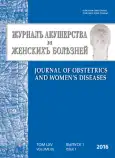Endometrial stem cells expansion capability for local and systemic routes of administration in a model of experimentally injured endometrium
- Authors: Usoltceva E.O1, Dzhemlikhanova L.K.1, Niauri D.A1, Kogan I.Y.2, Gzgzyan A.M1
-
Affiliations:
- St. Petersburg State University
- D.O. Ott Research Institute of Obstetrics and Gynecology RAMS
- Issue: Vol 65, No 1 (2016)
- Pages: 62-68
- Section: Articles
- URL: https://journals.rcsi.science/jowd/article/view/2933
- DOI: https://doi.org/10.17816/JOWD65162-68
- ID: 2933
Cite item
Full Text
Abstract
Full Text
##article.viewOnOriginalSite##About the authors
Elena O Usoltceva
St. Petersburg State University
Email: usolceva.elena@inbox.ru
MD. St. Faculty of Medicine, Department of Obstetrics, Gynecology and Reproductive Medicine
Liailia Kh Dzhemlikhanova
St. Petersburg State University
Email: office@inform.pu.ru
MD, Associate Professor of Obstetrics, Gynecology and Reproductive Medicine Department. Faculty of Medicine
Dariko A Niauri
St. Petersburg State University
Email: office@inform.pu.ru
MD, Professor, Head of Obstetrics, Gynecology and Reproductive Medicine Department
Igor Yu Kogan
D.O. Ott Research Institute of Obstetrics and Gynecology RAMS
Email: iagmail@ott.ru
MD, academic secretary
Alexander M Gzgzyan
St. Petersburg State University
Email: iagmail@ott.ru
MD, Professor of Obstetrics, Gynecology and Reproductive Medicine Department, Head of Reproductive Technologies Department. Faculty of Medicine
References
- Stoltz JF, de Isla N, Li YP, et al. Stem Cells and Regenerative Medicine: Myth or Reality of the 21th Century. Stem Cells Int. 2015;2015:734-731. doi: 10.1155/2015/734731.
- Земелько В.И., Гринчук Т.М., Домнина А.П., и др. Мультипотентные мезенхимные стволовые клетки десквамированного эндометрия. Выделение, характеристика и использование в качестве фидерного слоя для культивирования эмбриональных стволовых линий человека // Цитология. - 2011. - № 12. - С. 919-928. [Zemel’ko VI, Grinchuk TM, Domnina AP, et al. Multipotent mesenchymal stem cells out of desquamated endometrium. Isolation, characterization, and usage as a feeder layer for the cultivation of human embryonic stem lines. Tsitologiya. 2011;12:919-928. (In Russ).]
- Murakami K, Bhandari H, Lucas ES, et al. Deficiency in clonogenic endometrial mesenchymal stem cells in obese women with reproductive failure a pilot study. PLoS One. 2013 Dec 10;8(12): e82582. doi: 10.1371/journal.pone.0082582.
- Djokovic D, Calhaz-Jorge C. Somatic stem cells and their dysfunction in endometriosis. Front Surg. 2015 Jan 6;1:51. doi: 10.3389/fsurg.2014.00051.
- Zhong Z, Patel AN, Ichim TE, et al. Feasibility investigation of allogeneic endometrial regenerative cells. J Transl Med. 2009;7:15. doi: 10.1186/1479-5876-7-15.
- Ichim TE, Solano F, Lara F, et al. Combination stem cell therapy for heart failure. Int Arch Med. 2010 Apr 14;3(1):5. doi: 10.1186/1755-7682-3-5.
- Ichim TE, Alexandrescu DT, Solano F, et al. Mesenchymal stem cells as antiinflammatories: implications for treatment of Duchenne muscular dystrophy. Cell Immunol. 2010;260(2):75-82. doi: 10.1016/j.cellimm.2009.10.006.
- Айламазян Э.К., Гзгзян А.М., Савинов П.А., и др. Особенности реакции импланта аутологичного эндометрия на механическое воздействие в эксперименте // Журнал акушерства и женских болезней. - 2012. - № 3. - C. 22-30. [Ailamazian EK, Gzgzian AM, Savinov PA, et al. The endometrial implant’s reaction after the experimental mechanical tissue damage. Zhurnal akusherstva i zhenskikh boleznei. 2012;3:22-30. (In Russ).]
- Айламазян Э.К., Гзгзян А.М., Джемлиханова Д.Х., и др. Опыт получения стволовых клеток из менструальной крови // Журнал акушерства и женских болезней. - 2012. - № 5. - C. 25-29. [Aylamazyan EK, Gzgzyan AM, Dzhemlikhanova DKh, et al. The experience of obtaining stem cells from menstrual blood. Zhurnal akusherstva i zhenskikh bolezney. 2012;5:25-29. (In Russ).]
- Golpanian S, Schulman IH, Ebert RF, et al. Concise review: review and perspective of cell dosage and routes of administration from preclinical and clinical studies of stem cell therapy for heart disease. Stem Cells Transl Med. 2016 Feb;5(2):186-91. doi: 10.5966/sctm.2015-0101.
- Du G, Liu Y, Dang M, et al. Comparison of administration routes for adipose-derived stem cells in the treatment of middle cerebral artery occlusion in rats. Acta Histochem. 2014 Jul;116(6):1075-84. doi: 10.1016/j.acthis.2014.05.002.
- Suncion VY, Ghersin E, Fishman JE, et al. Does transendocardial injection of mesenchymal stem cells improve myocardial function locally or globally? An analysis from the POSEIDON randomized trial. Circ Res. 2014 Apr 11;114(8):1292-301. doi: 10.1161/CIRCRESAHA.114.302854.
- Leibacher J, Henschler R. Biodistribution, migration and homing of systemically applied mesenchymal stem/stromal cells. Stem Cell Res Ther. 2016 Jan 11;7(1):7. doi: 10.1186/s13287-015-0271-2.
- Кругляков П.В., Лохматова Е.А., Климович В.Б., Зарицкий А.Ю. Мезенхимальные стволовые клетки и иммунопатологические состояния организма // Клеточная трансплантология и тканевая инженерия. - 2006. - № 3 (5). - C. 36-41. [Kruglyakov PV, Lokhmatova EA, Klimovich VB, Zaritskiy AYu. Mesenchymal stem cells and immunopathological conditions. Kletochnaya transplantologiya i tkanevaya inzheneriya. 2006;3(5):36-41. (In Russ).]
- Брюховецкий И.С., Брюховецкий А.С., Мищенко П.В., Хотимченко Ю.С. Роль системных механизмов миграции и хоуминга стволовых клеток в развитии злокачественных опухолей центральной нервной системы и разработке новых методов противоопухолевой терапии // Российский биотерапевтический журнал. - 2013. - № 3. - C. 3-12. [Brjuhoveckij IS, Brjuhoveckij AS, Mishhenko PV, Hotimchenko JS. The role of systemic mechanisms of stem cells migration and homing in the development of malignant tumors of the central nervous system and the development of new anti-tumor therapies. Rossijskij bioterapevticheskij zhurnal. 2013;3:3-12. (In Russ).]
- Han X, Meng X, Yin Z, et al. Inhibition of intracranial glioma growth by endometrial regenerative cells. Cell Cycle. 2009 Feb 15;8(4):606-10. doi: 10.4161/cc.8.4.7731.
- Coughlan C, Ledger W, Wang Q, et al. Recurrent implantation failure: definition and management. Reprod Biomed Online. 2014 Jan;28(1):14-38. doi: 10.1016/j.rbmo.2013.08.011.
- van Velthoven CT, Kavelaars A, van Bel F, Heijnen CJ. Nasal administration of stem cells: a promising novel route to treat neonatal ischemic brain damage. Pediatr Res. 2010 Nov;68(5):419-22. doi: 10.1203/pdr.0b013e3181f1c289.
- Henning RJ, Burgos JD, Vasko M, et al. Human cord blood cells and myocardial infarction: effect of dose and route of administration on infarct size. Cell Transplant. 2007;16(9):907-17. doi: 10.3727/096368907783338299.
- Panciani PP, Fontanella M, Tamagno I, et al. Stem cells based therapy in high grade glioma: why the intraventricular route should be preferred? J Neurosurg Sci. 2012 Sep;56(3):221-9.
Supplementary files







